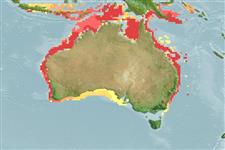分类 / Names
俗名 | 同种异名 | Catalog of Fishes(属, 种) | ITIS | CoL | WoRMS | Cloffa
Teleostei >
Scombriformes (Mackerels) >
Scombridae (Mackerels, tunas, bonitos) > Scombrinae
Etymology: Cybiosarda: Greek, kybion = tunna + Latin, sarda = sardine (Ref. 45335).
More on author: Whitley.
Environment: milieu / climate zone / depth range / distribution range
生态学
海洋; 海洋洄游的 (Ref. 51243); 深度上下限 50 - ? m. 熱帶; 6°S - 41°S, 108°E - 158°E (Ref. 168)
Western Pacific: restricted to the northern three quarters of Australia (absent from the south coast) and the southern coast of Papua New Guinea.
西太平洋: 侷限於北方的澳洲 (南部海岸沒有出現) 中的四分之三與巴布亞新幾內亞的南部海岸了。
大小 / 重量 / 年龄
Maturity: Lm ? range ? - ? cm
Max length : 45.0 cm FL 雄鱼/尚未辨别雌雄; (Ref. 168); common length : 35.0 cm FL 雄鱼/尚未辨别雌雄; (Ref. 168); 最大体重: 2.0 kg (Ref. 168)
背棘 (总数): 16 - 18; 背的软条 (总数): 17-19; 臀棘 0; 臀鳍软条: 15 - 17; 脊椎骨: 47 - 48. This species is distinguished by the following characters: body moderately short and deep, strongly compressed; mouth moderately large with upper jaw reaching to hind margin of eye; 2 tooth patches on upper surface of tongue; 13-22 large, conical teeth on upper jaw, 10-17 on lower jaw; 12-15 total gill rakers on first gill arch; l28-33 laminae of olfactory rosette; interorbital width 23.9 to 31% of head length; D1 XVI-XVIII,17-19, dorsal fins close together, the first high anteriorly, soft rays followed by 8-10 finlets; A 15-17 followed by 6-7 finlets; pectoral fins short with 22-24 rays; interpelvic process small and bifid; body mostly naked behind the well-developed corselet except for a band of scales along bases of dorsal and anal fins and patches of scales around bases of the pectoral and pelvic fins; caudal peduncle slender, with a well-developed lateral keel between 2 smaller keels on each side; no swimbladder, spleen not visible in ventral view, concealed under liver; liver with an elongate right lobe and a short left lobe which tends to fuse with the middle lobe; vertebrae 22-24 + 23-26 = 47-48. Colour of belly light with several stripes reminiscent of those of the skipjack tuna, Katsuwonus pelamis; back deep blue covered with elongate black spots; first dorsal fin jet black anteriorly, white in the few last posterior membranes; anal and second dorsal fins yellow (Ref. 9684).
嘴相当大, 上颌延伸到眼的后缘。 嗅觉毛簇的叶片 28 到 33. 腹鳍间的突起小而两裂的。 身体大部份裸露在后发展良好的甲胄除了一条鳞片的条纹胸鳍的基底与腹鳍的周围沿着背鳍基底与臀鳍与区块。 泳鳔不存在。 背部是深地蓝色的,覆盖着细长的黑色斑点; 腹面颜色较淡有一些像那鲣鱼的那些斑纹。
An epipelagic, neritic species that forms schools of several hundred individuals. Taken as bait for snappers by commercial fishers, and for marlins and sharks by sport fishers. Its meat is white and dry and is good when smoked or served steamed with moderately flavored white sauce.
一个表层带, 几百个个体形成鱼群的浅海的种。 作为了渔民的笛鲷诱饵, 与对于钓客的马林鱼与鲨鱼。 它的肉是白色而乾的而且是好当烟熏时或者适用于以一般调味的白酱油蒸了。
Life cycle and mating behavior
成熟度 | 繁殖 | 产卵场 | 卵 | 孕卵数 | 仔鱼
西太平洋: 侷限於北方的澳洲 (南部海岸沒有出現) 中的四分之三與巴布亞新幾內亞的南部海岸了。
Collette, B.B. and C.E. Nauen, 1983. FAO Species Catalogue. Vol. 2. Scombrids of the world. An annotated and illustrated catalogue of tunas, mackerels, bonitos and related species known to date. Rome: FAO. FAO Fish. Synop. 125(2):137 p. (Ref. 168)
人类利用
渔业: 低经济; 游钓鱼种: 是的; 诱饵: usually
更多信息
俗名同种异名新陈代谢捕食者生态毒物学繁殖成熟度产卵场产卵群集孕卵数卵卵的发育
参考文献养殖养殖信息品种遗传学Electrophoreses遗传率疾病加工NutrientsMass conversion
合作者照片Stamps, Coins Misc.声音神经毒速度泳型鳃区Otoliths脑重体重比眼睛色素
工具
特别资料
下载 XML
网络资源
Estimates based on models
Preferred temperature (Ref.
123201): 20.7 - 27.6, mean 26 °C (based on 165 cells).
Phylogenetic diversity index (Ref.
82804): PD
50 = 1.0000 [Uniqueness, from 0.5 = low to 2.0 = high].
Bayesian length-weight: a=0.00955 (0.00464 - 0.01966), b=3.05 (2.88 - 3.22), in cm total length, based on LWR estimates for this (Sub)family-body shape (Ref.
93245).
营养阶层 (Ref.
69278): 4.0 ±0.7 se; based on size and trophs of closest relatives
回复力 (Ref.
120179): 高度, 族群倍增时间少于 15个月 (Preliminary K or Fecundity.).
Fishing Vulnerability (Ref.
59153): Moderate vulnerability (40 of 100).
Nutrients (Ref.
124155): Calcium = 110 [58, 229] mg/100g; Iron = 1.89 [1.12, 3.14] mg/100g; Protein = 21 [20, 22] %; Omega3 = 0.332 [0.202, 0.541] g/100g; Selenium = 61.7 [31.4, 123.1] μg/100g; VitaminA = 29.8 [12.3, 77.0] μg/100g; Zinc = 0.916 [0.633, 1.352] mg/100g (wet weight);
